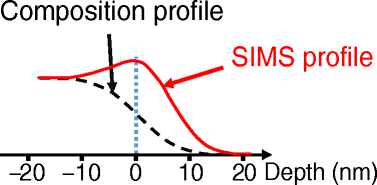Journal of the American Society for Mass Spectrometry ( IF 3.1 ) Pub Date : 2018-02-21 , DOI: 10.1007/s13361-018-1905-2 R Havelund 1 , M P Seah 1 , M Tiddia 2 , I S Gilmore 1
A procedure has been established to define the interface position in depth profiles accurately when using secondary ion mass spectrometry and the negative secondary ions. The interface position varies strongly with the extent of the matrix effect and so depends on the secondary ion measured. Intensity profiles have been measured at both fluorenylmethyloxycarbonyl-l-pentafluorophenylalanine (FMOC) to Irganox 1010 and Irganox 1010 to FMOC interfaces for many secondary ions. These profiles show separations of the two interfaces that vary over some 10 nm depending on the secondary ion selected. The shapes of these profiles are strongly governed by matrix effects, slightly weakened by a long wavelength roughening. The matrix effects are separately measured using homogeneous, known mixtures of these two materials. Removal of the matrix and roughening effects give consistent compositional profiles for all ions that are described by an integrated exponentially modified Gaussian (EMG) profile. Use of a simple integrated Gaussian may lead to significant errors. The average interface positions in the compositional profiles are determined to standard uncertainties of 0.19 and 0.14 nm, respectively, using the integrated EMG function. Alternatively, and more simply, it is shown that interface positions and profiles may be deduced from data for several secondary ions with measured matrix factors by simply extrapolating the result to Ξ = 0. Care must be taken in quoting interface resolutions since those measured for predominantly Gaussian interfaces with Ξ above or below zero, without correction, appear significantly better than the true resolution.

ᅟ
中文翻译:

有机材料的 SIMS——使用负二次离子的氩气团簇深度剖面中的界面位置
当使用二次离子质谱和负二次离子时,已经建立了一个程序来准确定义深度剖面中的界面位置。界面位置随基体效应的程度变化很大,因此取决于测量的二次离子。已在芴基甲氧羰基-l处测量强度分布-五氟苯丙氨酸 (FMOC) 到 Irganox 1010 和 Irganox 1010 到 FMOC 接口,用于许多次级离子。这些分布图显示了两个界面的分离,根据选择的二次离子,在大约 10 nm 范围内变化。这些轮廓的形状受基质效应的强烈控制,因长波长粗糙化而略微减弱。使用这两种材料的均匀已知混合物分别测量基质效应。去除基质和粗糙化效应为所有离子提供一致的成分分布,这些分布由集成的指数修正高斯 (EMG) 分布描述。使用简单的积分高斯可能会导致重大错误。成分分布中的平均界面位置分别确定为 0.19 和 0.14 nm 的标准不确定度,使用集成的 EMG 功能。或者,更简单地说,它表明可以通过简单地将结果外推到具有测量的基质因子的几个次级离子的数据推导出界面位置和轮廓Ξ = 0。在引用界面分辨率时必须小心,因为对于Ξ高于或低于零的主要高斯界面测量的那些,未经校正,看起来明显好于真实分辨率。

ㅟ











































 京公网安备 11010802027423号
京公网安备 11010802027423号